|
|
|
|
|
|
|
|
|
|
|
|
|
|
|
|
|
Return
to Biology 1114 Index Page

Preview
Material for Exam 1 - Fall 2002
Print
the PDF version (no pictures, better printing) |
|
|
|
Pogonomyrmex occidentalis,
the western harvester ant, is common in the western United States where it
is found even at cool and dry elevations above 5,000 feet. These ants live
in colonies and build cone-shaped mounds that stand about 20 inches (50 cm)
tall. The mounds have elliptical (oval) bases. The ants clear most of the
vegetation from around the mounds for about 3-6 feet in all directions so
that the mounds are not shaded. The colony's tunnels extend nearly 9 feet
(2.7 meters) below the soil surface and connect various chambers. Because
ants are poikilothermic, temperature of the mound is critical to activity
levels of adults and developmental rates of juvenile ants. Several factors
influence mound temperature. Externally, sunlight and air temperature will
alter the temperature inside the mound. Internally, metabolic activity of
bacteria decomposing waste material inside the mound and metabolic activity
of the ants themselves will warm the mound. In many species of ants and termites,
thermoregulation appears to be an important function of mound geometry and
the asymmetrical shape of this species' mounds has led researchers to suspect
the same for P. occidentalis.
|
|
|
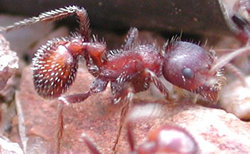 source source |
|
|
|
|
|
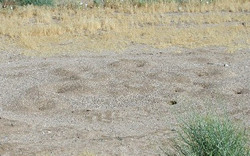
source |
|
|
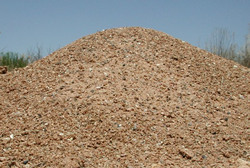
source |
|
|
|
|
|
|
|
|
|
|
|
|
|
In
a recent study to examine whether P. occidentalis shapes its mounds to
catch the morning sun and thus aid in thermoregulation, a researcher recorded
subsoil temperatures on all 4 sides of the mound as well as 2 off-mound temperatures.
This was accomplished by inserting the tip of a digital thermometer 1.6 inches
(4 cm) into the mound on each of the 4 cardinal sides (E, W, N, S) at a distance
of 4 inches (10 cm) from the apex (top) of the mound. The off-mound temperatures
(at 4 cm depth) were recorded in sunlit, bare soil and then in a shaded area.
Temperatures were recorded at two different times during the day (morning -
when the sun was up and afternoon when the sun was going down) and on three
different days during the summer. The investigator also measured the grade/steepness
of each side of the mound. A less steep slope would expose more surface area
to the sun and thus absorb more radiant energy during each day. |
|
|
 source source |
|
|
|
|
|
|
|
|
|
|
|
|
|
|
|
 source source |
|
|
|
Brady
Brine lives on the Gulf of Mexico coast, and is a lifelong saltwater fisherman.
Although he is very knowledgeable about ocean fishing, Brady has led a sheltered
life and has little education or experience beyond his small town. While vacationing
in the western U.S., Brady pulls off the road in his RV, and takes out his favorite
fishing rod to try fishing in Great Salt Lake (GSL), Utah. He figures that any
lake with the word "salt" in it must be just like the ocean, so he
daydreams of grilling some fresh-caught flounder for dinner. Earlier, he had
stopped by "Bubba's Bait-n-Tackle" shop near a (freshwater) stream
to pick up some minnows for bait. Not wanting to brag about his fishing skills,
Brady didn't tell the owner where he planned to fish. Too bad, because Bubba
would have told him that his fishing efforts would be futile. GSL is about 25-30%
salt (mostly NaCl, close to saturation), compared to only 3.5% in the oceans,
so salty that only a few specially-adapted species of bacteria, algae and brine
shrimp can survive. |
|
|
|
|
|
|
|
 source source |
|
|
|
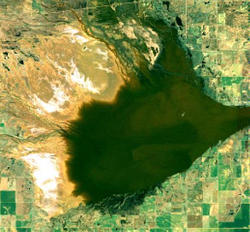 source source |
|
|
|
|
|
|
|
|
|
|
|
|
|
On
the way home to Louisiana, Brady stops at the Great Salt Plains Lake in western
Oklahoma. This time he talks to the locals, who tell him that the fishing really
is good in the lake. He learns that the salinity of the lake is only about 0.4%
(less salty than fish cells), and the fish are typical freshwater species. He
tries an experiment in which he mixes varying proportions of water from GSL
(which he collected as a souvenir) and the Great Salt Plains Lake to make different
salinities, and checks survival of freshwater minnows in each mixture. |
|
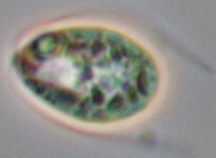 |
|
|
|
|
|
|
Seeds
of plums, apricots, cherries, peaches and almonds contain a substance called
amygdalin. Amygdalin is responsible for the familiar taste and scent of bitter
almonds. Chemically it is a cyanogenic glycoside that can produce hydrogen cyanide
(HCN, a secondary metabolite) whenever plant tissue containing it is crushed
or damaged. Also, HCN molecules are released when the seeds are digested. The
production of HCN from amygdalin is facilitated by enzyme activity. In intact
tissue, the amygdalin and the enzyme reside in different compartments; therefore,
no reaction occurs in the plant. When the tissue is damaged or digested by an
animal, the walls of the compartments are destroyed, allowing the enzyme to
bind with amygdalin and release HCN. In an animal, HCN molecules disrupt the
metabolic activity of the mitochondria because they stop the electron transport. |
|
|
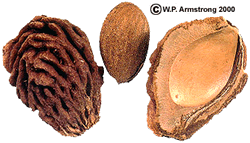 source source |
|
|
|
|
|
 source source |
|
|
|
|
|
|
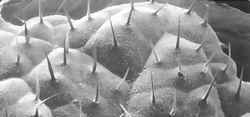 |
 |
 |
|
An
entomologist interested in the life history of a particular moth species has
been collecting data on the feeding habits of the caterpillar stage (the immature
or juvenile). After closer examination, she notices that the caterpillars spin
silk over the surfaces of the leaves on which they feed. On closer inspection,
she notices that the caterpillars use the silk to protect themselves from the
trichomes (tiny, hooked, sharp, plant hairs that puncture and kill insects)
found on these leaves. Curious about her observations, she looked back in her
notes. She found that 20 years ago the caterpillars in her lab did not spin
silk over the leaves as they walked. Then she went to the library and read that
other scientists had observed this type of caterpillar eating such leaves 100
years ago, but they did not report the caterpillars spinning silk over the leaves.
She then checked leaf samples in the herbarium and discovered that 50 years
ago, these plants did not possess as many trichomes. "Eureka", she
remarks, "I have proven that coevolution has occurred in these two species." |
 |
 |
 |
 |
 |
 |
 |
 |
 |
 |
 |
 |
 |
 |
 |
 |

 source
source

 source
source source
source source
source source
source
 source
source source
source

